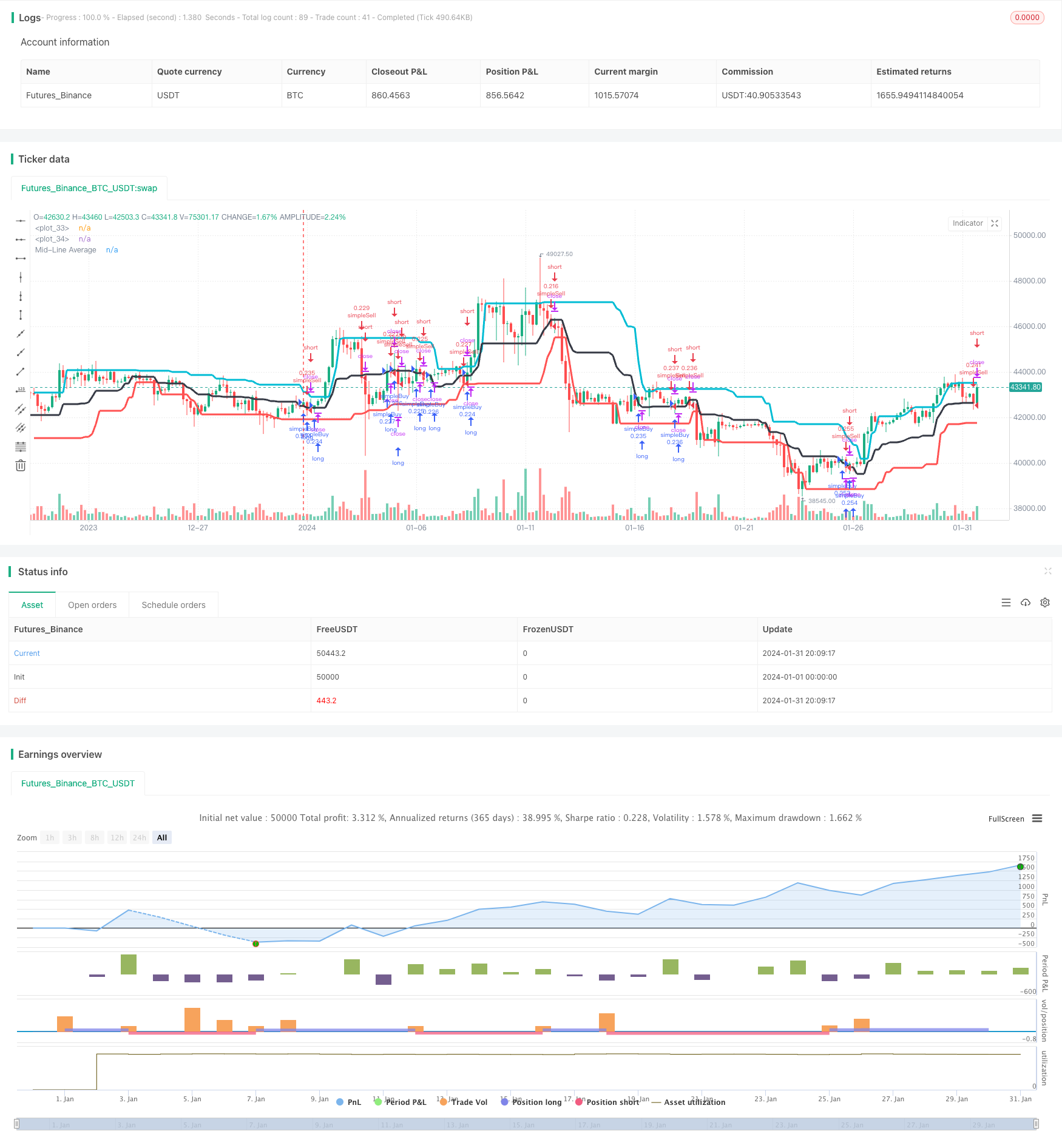Trend Following Moving Average Strategy
Author: ChaoZhang, Date: 2024-02-29 14:00:35Tags:

Overview
This strategy calculates the channel moving average lines and establishes long or short positions when the price breaks through the channel lines to follow the trend of the stock price. It belongs to the trend following strategy.
Strategy Principle
The strategy first calculates the 20-day high average as the upper rail of the channel, the 20-day low average as the lower rail of the channel, and calculates the midline of the channel. The midline of the channel represents the recent average price trend. When the price breaks through the midline of the channel upwards, a long position is established. When the price breaks through the midline of the channel downwards, a short position is established. Follow the price trend until the price falls back to the opposite side of the channel range, close the position.
Advantage Analysis
- Use the channel to track price trends, avoid funds being locked in ranging markets;
- Channel rails help determine entry and exit points, making it easy to control entries;
- The channel range filters out some noise and increases profit probability;
- The channel parameters can be adjusted to tune the sensitivity of the strategy;
Risk Analysis
- Significant midline breakouts may be followed by pullback tests of the midline, resulting in being trapped;
- Oscillating stocks are not suitable for this strategy and may lead to high frequency trading;
- Improper parameter settings may also affect strategy performance;
Optimization Directions
- Optimize channel cycle parameters to test impacts of different parameters;
- Add profit taking and stop loss strategies to control single and total losses;
- Combine other indicators as auxiliary judgements to avoid wrong signals;
- Take positions in batches to reduce the probability of being trapped during pullback tests;
Summary
In general, this strategy is relatively simple and straightforward. It judges stock price trends through basic price channels and belongs to the trend following type. The advantages are easy operation, full use of investment opportunities brought by price trends, and avoiding fund lock-ups. The disadvantages are that improper parameter settings may affect performance and there are certain risks of pullback tests. Through reasonable optimization, the stability of the strategy can be improved and real trading performance can be enhanced.
/*backtest
start: 2024-01-01 00:00:00
end: 2024-01-31 23:59:59
period: 4h
basePeriod: 15m
exchanges: [{"eid":"Futures_Binance","currency":"BTC_USDT"}]
*/
//@version=3
//future strategy
//strategy(title = "stub", default_qty_type = strategy.fixed, default_qty_value = 1, overlay = true, commission_type=strategy.commission.cash_per_contract,commission_value=2)
//stock strategy
strategy(title = "dc", default_qty_type = strategy.percent_of_equity, default_qty_value = 20, overlay = true, commission_type=strategy.commission.cash_per_contract,commission_value=.005)
//forex strategy
//strategy(title = "stub", default_qty_type = strategy.percent_of_equity, default_qty_value = 20, overlay = true)
//crypto strategy
//strategy(title = "stub", default_qty_type = strategy.percent_of_equity, default_qty_value = 20, overlay = true, commission_type=strategy.commission.percent,commission_value=.25,default_qty_value=20)
testStartYear = input(2000, "Backtest Start Year")
testStartMonth = input(1, "Backtest Start Month")
testStartDay = input(1, "Backtest Start Day")
testPeriodStart = timestamp(testStartYear,testStartMonth,testStartDay,0,0)
testEndYear = input(2019, "Backtest Start Year")
testEndMonth = input(3)
testEndDay = input(31, "Backtest Start Day")
testPeriodEnd = timestamp(testStartYear,testStartMonth,testStartDay,0,0)
testPeriod() =>
true
//time >= testPeriodStart ? true : false
dcPeriod = 20
dcUpper = highest(close, dcPeriod)[1]
dcLower = lowest(close, dcPeriod)[1]
dcAverage = (dcUpper + dcLower) / 2
plot(dcLower, style=line, linewidth=3, color=red, offset=1)
plot(dcUpper, style=line, linewidth=3, color=aqua, offset=1)
plot(dcAverage, color=black, style=line, linewidth=3, title="Mid-Line Average")
strategy.entry("simpleBuy", strategy.long, when=close > dcAverage)
strategy.close("simpleBuy",when=close < dcLower)
strategy.entry("simpleSell", strategy.short,when=close < dcAverage)
strategy.close("simpleSell",when=close > dcAverage)
- Dual Moving Average Channel Trading Strategy
- Adaptive Channel Breakout Strategy
- An Advanced EMA Trend Following Strategy with Relaxed RSI and ATR Filters
- Triple Confirmation Trend Tracking Strategy
- Multiple Moving Average Trading Strategy
- Turtle Trading Decision System
- Wave Buying and Selling Reversal 5 Minutes Timeframe Strategy
- RSI-based Auto Trading Strategy
- The Compound Breakout Strategy
- The Momentum Breakout Strategy
- Momentum Crossover Strategy with Dynamic Trailing Stop Loss
- EMA and RSI Quantitative Trading Strategy
- Momentum Trend Strategy Based on MACD and Bollinger Bands
- Multi-Timeframe Stochastic Strategy
- Moving Average Crossover Strategy with Intraday Candlestick Patterns
- Bitcoin Scalping Strategy Based on Moving Average Crossover and Candlestick Patterns
- Momentum and Moving Average Combination Long Strategy
- Momentum Average Directional Movement Index Moving Average Crossover Strategy
- Dual EMA Crossover Trend Tracking Strategy
- Double Moving Average and MACD Combination Trading Strategy